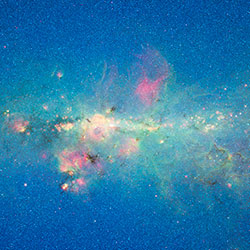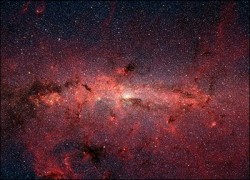
The new 55-meter image that was unveiled today is impressive, but does it hold any scientific value? A resounding yes to that question came from astronomers who helped work on this project, and given the standing room only for the oral presentation of the scientific research going into this image, plenty of other astronomers are interested in the discoveries from Spitzer's five-year effort of gathering infrared data of our home galaxy. "This is a legacy science project," said Barbara Whitney of the Space Science Institute, "that shows star formation as never seen before on both the large and small scale. Most of these star forming regions are being seen for the first time."
"This is the highest-resolution, largest, most sensitive infrared picture ever taken of our Milky Way," said Sean Carey of NASA's Spitzer Science Center. "Where previous surveys saw a single source of light, we now see a cluster of stars. With this data, we can learn how massive stars form, map galactic spiral arms and make a better estimate of our galaxy's star-formation rate," Carey explained.
From our vantage point on Earth, we see the Milky Way as a blurry, narrow band of light that stretches across the sky. In the visible, we only see about 5% of what's actually out there. But with Spitzer's dust-piercing infrared eyes, astronomers have peered 60,000 light-years away into this fuzzy band, called the galactic plane, and saw all the way to the other side of the galaxy.
The result is a cosmic tapestry depicting an epic coming-of-age tale for stars.
While evolved stars are seen as blue, the star forming regions are seen as green. The regions where young stars reside are revealed as "bubbles," or curved ridges in the green clouds. These bubbles are carved by the winds from the outflow of dust from the young stellar objects. The starlets appear as yellow and red dots, and wisps of red are dust particles.
"With these Spitzer data, we've been able to catalogue more than 100 million stars," said Edward Churchwell of the University of Wisconsin, at Madison.
"This picture shows us that our Milky Way galaxy is a crowded and dynamic place. We have a lot to learn. I've definitely found a lot of things in this map that I didn't expect to see," said Carey.
Source : http://www.universetoday.com/2008/06/03/so-what-do-astronomers-do-with-a-55-meter-long-image/





 RSS Feed (xml)
RSS Feed (xml)
